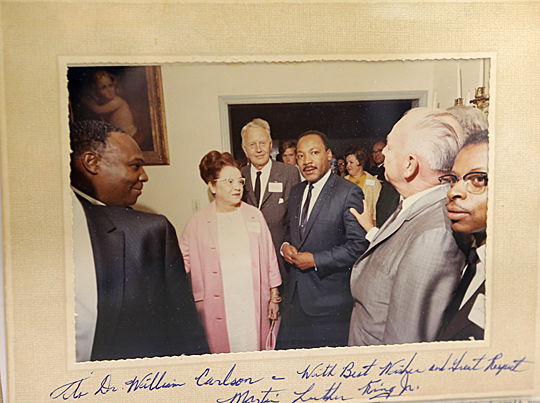What do Charles Darwin, Maya Angelou, J. Edgar Hoover, Margaret Mead and T. S. Eliot have in common?

Dr. Martin Luther King Jr. signed this photo that was taken in Toledo on Sept. 22, 1967, when he spoke at a rally at Scott High School. The photo was given to then-UT President William S. Carlson.
The free, public exhibit will open Monday, Oct. 21.
“The signature of an important person from our past is a singular, proven connection to a significant individual’s life,” said Barbara Floyd, director of the Canaday Center. “There is a significance to those signatures that cannot be easily described, but which draws one to whatever it is they signed.”
The staff of the Canaday Center spent the past year culling through its 6,000 feet of manuscript collections to locate letters signed by important persons. They located letters from political leaders, business innovators, intellectuals, celebrities, sports figures, authors, foreign dignitaries and famous Toledoans.
In addition to the notable people, Floyd said the exhibit also features letters from ordinary people who describe extraordinary events. “To me, this is where the art of correspondence really impacts,” Floyd said.Among the letters of ordinary people on display is a note from a person known only as Belle, who writes to someone named Matilda in May 1862 about an acquaintance — George — who left that morning to join the Union forces during the Civil War. The letter poignantly describes how Belle and her mother both cried, and how George, too, nearly cried.
“The ink on the letter is smudged in one spot, as if a drop of water had hit the page,” Floyd said. “One can only imagine that it was Belle’s tears that stained the letter.”
Because there are no additional letters from Belle, one is left to ponder the fate of George.
The signatures of foreign dignitaries include a guest book from the American Embassy in Moscow in December 1963. It includes the signatures of all of the leaders of the Soviet Union at the time. The leaders came to the embassy to pay their respects to Ambassador Foy D. Kohler on the death of President John F. Kennedy. The guest book includes signatures from Nikita Khrushchev, Andrei Gromyko and Krushchev’s wife. Also documenting this tragedy are letters from ordinary Soviet citizens who wrote heartfelt letters to the ambassador expressing their grief on the death of the president.
“At the height of the Cold War, these letters show that the Soviet Union was deeply affected by the assassination of Kennedy,” Floyd said. “One might not expect such sentiments, but they provide a glimpse into the lives of people that we would not otherwise know.”The exhibit also contains letters of people as varied as Henry Clay, Langston Hughes, Susan B. Anthony and Helen Keller. The latter is signed in Keller’s distinctive printed block letters reflecting the writing style she learned after losing her sight as a young child.
In addition to the “Letters of Luminaries,” the Canaday Center also has organized a smaller exhibit on the fifth floor of Carlson Library adjacent to the center titled “Celebrity Sightings.” It features enlargements of signed photographs of famous people from the Canaday Center’s holdings; these include Orson Welles, Katherine Hepburn, H.G. Wells and President Franklin D. Roosevelt.
Of note is an enlargement of a photograph taken in Toledo on Sept. 22, 1967, of Dr. Martin Luther King Jr. that was signed by King and given to then-UT President William S. Carlson. It was the only appearance by King in Toledo; he spoke that day at a rally at Scott High School. The photograph was taken at a reception after the speech.
Also included in this exhibit are copies of pages from scrapbooks maintained by the UT Office of Special Events from 1976 to the early 1990s that document concerts performed in Centennial Hall, now known as Savage Arena. These scrapbook pages include signatures and sentiments from Bob Dylan, Cher, Steve Martin and Bill Cosby, among others.
The exhibits will be on display Monday through Friday from 8 a.m. to 5 p.m. through July 31, 2014.
Special and group showings can be arranged by calling 419.530.4480.
For more information, contact Floyd at 419.530.2170 or barbara.floyd@utoledo.edu.